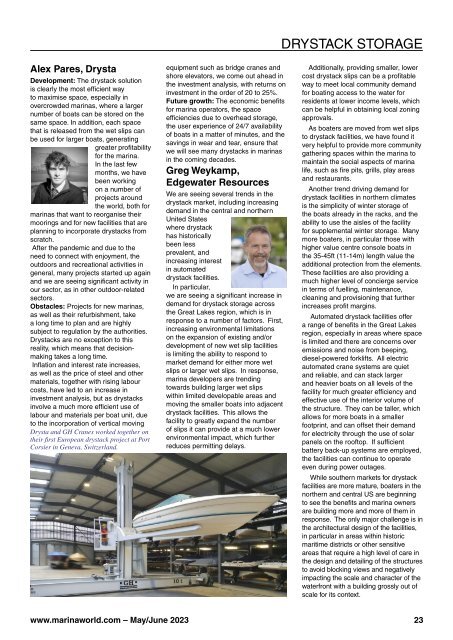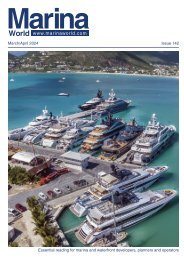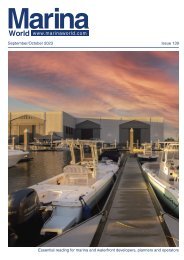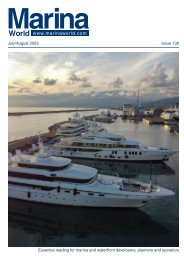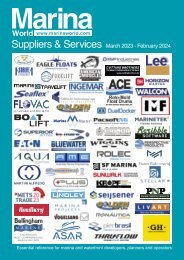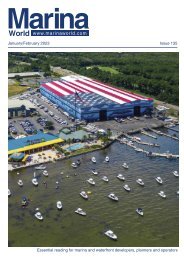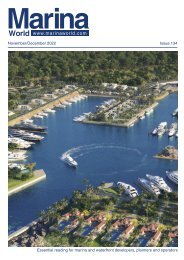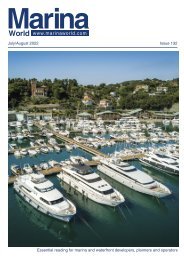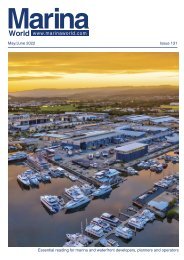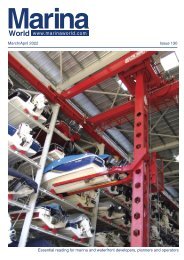2023 May June Marina World
The magazine for the marina industry
The magazine for the marina industry
Create successful ePaper yourself
Turn your PDF publications into a flip-book with our unique Google optimized e-Paper software.
DRYSTACK STORAGE<br />
Alex Pares, Drysta<br />
Development: The drystack solution<br />
is clearly the most efficient way<br />
to maximise space, especially in<br />
overcrowded marinas, where a larger<br />
number of boats can be stored on the<br />
same space. In addition, each space<br />
that is released from the wet slips can<br />
be used for larger boats, generating<br />
greater profitability<br />
for the marina.<br />
In the last few<br />
months, we have<br />
been working<br />
on a number of<br />
projects around<br />
the world, both for<br />
marinas that want to reorganise their<br />
moorings and for new facilities that are<br />
planning to incorporate drystacks from<br />
scratch.<br />
After the pandemic and due to the<br />
need to connect with enjoyment, the<br />
outdoors and recreational activities in<br />
general, many projects started up again<br />
and we are seeing significant activity in<br />
our sector, as in other outdoor-related<br />
sectors.<br />
Obstacles: Projects for new marinas,<br />
as well as their refurbishment, take<br />
a long time to plan and are highly<br />
subject to regulation by the authorities.<br />
Drystacks are no exception to this<br />
reality, which means that decisionmaking<br />
takes a long time.<br />
Inflation and interest rate increases,<br />
as well as the price of steel and other<br />
materials, together with rising labour<br />
costs, have led to an increase in<br />
investment analysis, but as drystacks<br />
involve a much more efficient use of<br />
labour and materials per boat unit, due<br />
to the incorporation of vertical moving<br />
Drysta and GH Cranes worked together on<br />
their first European drystack project at Port<br />
Corsier in Geneva, Switzerland.<br />
equipment such as bridge cranes and<br />
shore elevators, we come out ahead in<br />
the investment analysis, with returns on<br />
investment in the order of 20 to 25%.<br />
Future growth: The economic benefits<br />
for marina operators, the space<br />
efficiencies due to overhead storage,<br />
the user experience of 24/7 availability<br />
of boats in a matter of minutes, and the<br />
savings in wear and tear, ensure that<br />
we will see many drystacks in marinas<br />
in the coming decades.<br />
Greg Weykamp,<br />
Edgewater Resources<br />
We are seeing several trends in the<br />
drystack market, including increasing<br />
demand in the central and northern<br />
United States<br />
where drystack<br />
has historically<br />
been less<br />
prevalent, and<br />
increasing interest<br />
in automated<br />
drystack facilities.<br />
In particular,<br />
we are seeing a significant increase in<br />
demand for drystack storage across<br />
the Great Lakes region, which is in<br />
response to a number of factors. First,<br />
increasing environmental limitations<br />
on the expansion of existing and/or<br />
development of new wet slip facilities<br />
is limiting the ability to respond to<br />
market demand for either more wet<br />
slips or larger wet slips. In response,<br />
marina developers are trending<br />
towards building larger wet slips<br />
within limited developable areas and<br />
moving the smaller boats into adjacent<br />
drystack facilities. This allows the<br />
facility to greatly expand the number<br />
of slips it can provide at a much lower<br />
environmental impact, which further<br />
reduces permitting delays.<br />
Additionally, providing smaller, lower<br />
cost drystack slips can be a profitable<br />
way to meet local community demand<br />
for boating access to the water for<br />
residents at lower income levels, which<br />
can be helpful in obtaining local zoning<br />
approvals.<br />
As boaters are moved from wet slips<br />
to drystack facilities, we have found it<br />
very helpful to provide more community<br />
gathering spaces within the marina to<br />
maintain the social aspects of marina<br />
life, such as fire pits, grills, play areas<br />
and restaurants.<br />
Another trend driving demand for<br />
drystack facilities in northern climates<br />
is the simplicity of winter storage of<br />
the boats already in the racks, and the<br />
ability to use the aisles of the facility<br />
for supplemental winter storage. Many<br />
more boaters, in particular those with<br />
higher value centre console boats in<br />
the 35-45ft (11-14m) length value the<br />
additional protection from the elements.<br />
These facilities are also providing a<br />
much higher level of concierge service<br />
in terms of fuelling, maintenance,<br />
cleaning and provisioning that further<br />
increases profit margins.<br />
Automated drystack facilities offer<br />
a range of benefits in the Great Lakes<br />
region, especially in areas where space<br />
is limited and there are concerns over<br />
emissions and noise from beeping,<br />
diesel-powered forklifts. All electric<br />
automated crane systems are quiet<br />
and reliable, and can stack larger<br />
and heavier boats on all levels of the<br />
facility for much greater efficiency and<br />
effective use of the interior volume of<br />
the structure. They can be taller, which<br />
allows for more boats in a smaller<br />
footprint, and can offset their demand<br />
for electricity through the use of solar<br />
panels on the rooftop. If sufficient<br />
battery back-up systems are employed,<br />
the facilities can continue to operate<br />
even during power outages.<br />
While southern markets for drystack<br />
facilities are more mature, boaters in the<br />
northern and central US are beginning<br />
to see the benefits and marina owners<br />
are building more and more of them in<br />
response. The only major challenge is in<br />
the architectural design of the facilities,<br />
in particular in areas within historic<br />
maritime districts or other sensitive<br />
areas that require a high level of care in<br />
the design and detailing of the structures<br />
to avoid blocking views and negatively<br />
impacting the scale and character of the<br />
waterfront with a building grossly out of<br />
scale for its context.<br />
www.marinaworld.com – <strong>May</strong>/<strong>June</strong> <strong>2023</strong><br />
23


